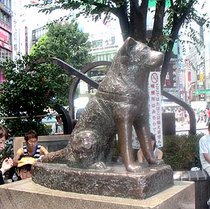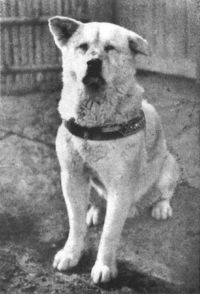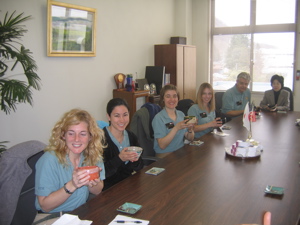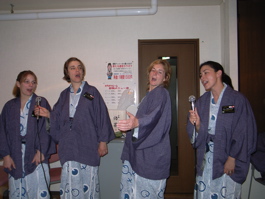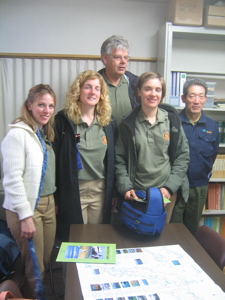Sipping tea in my cozy nest of a room at the New Hotel Carina in Morioka while staring out over the frosted city. The sun, slowly but surely, has risen in the sky, yet it hasn’t prevailed over the chilled air. Last night I slept fairly well, as our guide, Takashi Okada’s advice about drinking lots of sake and pulling a late night definitely worked.
Takashi has been an amazing host. He’s a lively man with a fun sense of humor, whether teasing Andy about his size 14 shoes or trying to convince us (unsuccessfully) about the virtues of natto. Today, after we viewed, quite incredulously, a display of smoked eggs, he dashed into a small store and purchased some for us to try. 
Yesterday he took us to the Sakurayama Shrine and when we inquired about Japanese writing, he secured a paper and brush pen and wrote all of our names in all three styles of Japanese charcters: katakana, hiragana, and kanji. Kanji is more than a language, it’s artistic expression, and it’s a prime example of the importance of aesthetics to the Japanese people. A few minutes later Takashi’s cell phone rang “Take My Breath Away,” by Berlin and I had to laugh as the song sounded. A strange juxtaposition of 80’s music and centuries old art.
A rotary exchange is truly something to behold. Andy, our group leader, has used the phrase, “family of Rotarians” and it certainly applies. We’ve received the royal treatment and everyone we’ve met has gone out of his or her way to make this trip enjoyable.
This morning I took a walk in Iwate Park, which is built on the ruins of Morioka Castle on a hill overlooking the confluence of three rivers: Kitakami, Nakatsu-gawa and Shizu Kushi. Nestled in downtown Morioka, the park contains many winding paths, a totem pole, a missing horse statue (melted down during WWII for iron), and a memorial to the poet Takaboka Ishikawa.
During my morning walk, people greeted me with a friendly good morning—being one of the few non-Japanese in the entire city has made me the object of much curiosity. I strolled along the Nakatsu-gawa River and watched the ducks swim. Dogs abounded, their owners taking them out for their morning walk. (One truth is universal—no matter where you are, everybody loves dogs.) A designated swan migration area exists along the Kitakami River, and a flock of the graceful white birds flew overhead while I walked.
Later in the day Takashi drove us to the Morioka Handi Craft Square, where we made our own rice crackers, sampled dango (a popular food of rice balls on sticks covered with the sauce of your choice), and made tie-dyes at Nambu Kodaizome.  In the square we also toured a Nambu Magariya, a traditional Japanese farmhouse. The barn and house are built together; I would like waking up and seeing my horse in the same room! On the way back to our hotel, we stopped by Koiwai Farm, a beautiful parcel of land surrounded by the Kitakami Mountains.
In the square we also toured a Nambu Magariya, a traditional Japanese farmhouse. The barn and house are built together; I would like waking up and seeing my horse in the same room! On the way back to our hotel, we stopped by Koiwai Farm, a beautiful parcel of land surrounded by the Kitakami Mountains.
Our dinner last night, termed by Takashi as the “Mt. Everest” of Japanese meals, will be very difficult to top. Takashi ordered every delicacy for us to sample: hoya (sea cucumber), squid, roasted bamboo, seaweed salad, crab, tuna, etc. I had about 50 glasses of sake and feasted on the most delicious oysters I’ve ever tasted. The grand finale? A giant dessert of battered covered ice cream in the shape of Half Dome.
Tomorrow we journey to Miyako, on the coast. Stay tuned for more fun adventures!
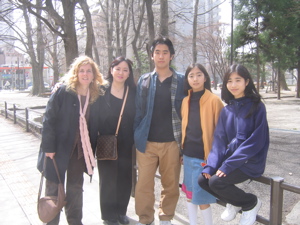 Today Julie and her family picked me up at the hotel and showed me a splendid day in Sendai. Her husband, Heizo, gave me a tour of his family’s sake factory; the Isawa’s have been making sake for over 300 years.
Today Julie and her family picked me up at the hotel and showed me a splendid day in Sendai. Her husband, Heizo, gave me a tour of his family’s sake factory; the Isawa’s have been making sake for over 300 years. 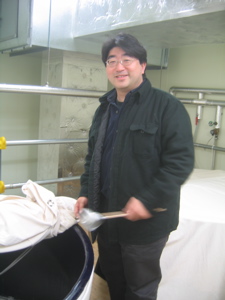 For lunch, we ate at a Japan version of Hometown Buffet, but one with much better food. Euka helped me choose from the vast array of food; she also checked off all of my selections on a menu so I could see how much I ate. Highlights included an egg soft boiled in the onsen (hot spring) waters, and dried tofu. Thankfully, I did not have to eat any natto.
For lunch, we ate at a Japan version of Hometown Buffet, but one with much better food. Euka helped me choose from the vast array of food; she also checked off all of my selections on a menu so I could see how much I ate. Highlights included an egg soft boiled in the onsen (hot spring) waters, and dried tofu. Thankfully, I did not have to eat any natto.
